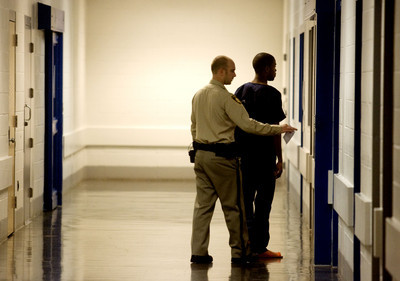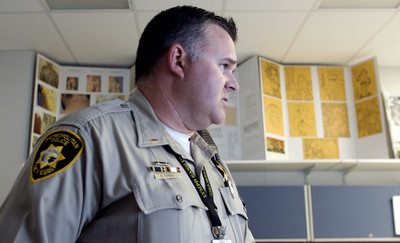GANG MEMBERS TOE LINE IN JAIL
Las Vegas police Lt. Rich Forbus has seen a lot of gang members come and go during his 12 years at the Clark County Detention Center.
Though none of them want to stick around, he says the experience has at least one thing going for it:
Gang members are safer in the downtown Las Vegas jail than they are on the streets.
Under his watch, no jail inmates have died from fighting.
"It's absolutely safer," Forbus said. "There are fights that happen. There are arguments that happen here that carry out once they're in the streets. But once they're in here, they're safe."
Forbus credited the secure atmosphere to the strict supervision that jail officials provide along with round-the-clock monitoring for weapons.
He also cited the Metropolitan Police Department's strategy in dealing with the jail's gang population. Inmates from specific gangs are not grouped together or separated based on race, like some jails in Los Angeles and throughout California used to do.
Forbus said a 2005 U.S. Supreme Court decision prevents jail and prison officials from segregating their populations based on race, noting that most gangs are formed along racial lines.
Gang members are spread throughout the jail based on a variety of factors, including the seriousness of the crime they are accused of and their criminal history, Forbus said.
For example, a person in jail for not paying parking tickets would not be placed with an inmate accused of murder.
Forbus said rival gang members sometimes are separated from each other; but when inmates from different gangs are placed together within the jail's general population, they aren't able to establish a hierarchy like they do on the streets.
"These people are expected to abide by rules and live with each other once they are in here," he said. "We're cutting off their power base and their organizational structure."
Jail officials also counter gangs inside the jail by having a group of officers monitor the gang climate.
Inside the offices of the Intelligence Section, cardboard cutouts sit on top of a ledge picturing the latest gang signs and tattoos.
Mike Funes, a corrections officer with the Intelligence Section, has been working with the unit for two years. The unit also acts as a liaison between what occurs in the jail and street gang activity.
Funes said the most difficult part of his job at first was keeping up with the constantly changing gang signs.
But he has gotten better at recognizing gang signs and vernacular by interacting with inmates on a daily basis.
Some children are born into gangs if their parents are gang members, he said. Those children can become full-fledged gang members as early as age 12.
Staying abreast of street gangs is an ever-evolving process, he said.
"Any street name that's out there, they probably named a gang after," Funes said.
In a mid-May visit to the jail, 280 of the 3,403 inmates were identified gang members.
Forbus said the most gang members the jail has had at any one time is between 300 and 400.
Corrections officials take other, more common steps to keep gangs under control inside the jail's cinder-block walls.
Inmates are required to wear blue shirts and pants.
Inmates are spread throughout two towers, the north and the south.
Inmates who behave poorly or who are accused of serious crimes are placed in 70- to 90-square-foot isolation cells. Each cell has a toilet, sink, bed, desk and stool. Guards conduct room checks twice an hour.
Inmates who are on good behavior or are accused of less serious crimes are allowed to stay in what jail officials call the open-dorm area, where they also have a bed, desk and stool. Those dorm areas can house up to 74 inmates.
In 2007, the latest data available, inmates stayed at the jail an average of 10 days, Forbus said. But some inmates have been at the jail for years awaiting court dates.
Jail officials in the south tower get from place to place by swiping electronic badges which open glass and metal doors. Other doors are opened and closed from a control room.
In the north tower, jail officials' moves are monitored through a camera system by a central office. Cameras are everywhere in common areas of the jail except showers and cells holding only one inmate.
Jail officials throughout the facility don't carry guns; they don't want to risk inmates reaching for them.
"All we carry here is pepper spray and keys," Forbus said.
Lt. John McGrath, with the Police Department's Gangs Crime Bureau, said Southern Nevada has about 8,399 gang members from 391 gangs. Over the past six years, the number of gang members has fluctuated between 8,000 and 10,000, peaking in 2002.
McGrath said police seem to be making inroads in their fight against gangs. Gang shootings decreased from 274 in 2006 to 185 in 2007. Shootings are down 19 percent through May 2008 to 50 shootings, compared with 62 shootings through the same time last year.
McGrath said that's because police have been focusing on solving those incidents as quickly as possible. That reduces the risk of having retaliatory shootings from rival gangs while an investigation is going on.
"Every major (gang-related) shooting we've had in the past year, we've solved and put people in jail," McGrath said.
Contact reporter Antonio Planas at aplanas@reviewjournal.com or 702-383-4638.



















